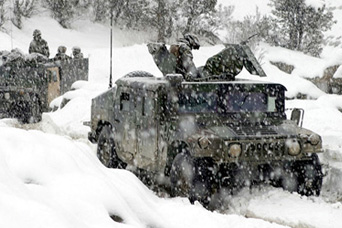Directions

Directions from Fairbanks International Airport
provided by Google Maps
Traveling Tips
When you arrive in the afternoon after your long trip to Alaska, plan to spend your first night in Fairbanks. Depart Fairbanks for ARTC in the morning.
Appropriate winter clothing can be purchased in Fairbanks before the traveler proceeds to ARTC. Winter clothing can also be purchased in Delta Junction after arrival.
Persons or groups should notify ARTC of their departure time from Fairbanks and should check in when they arrive at ARTC. The call will ensure safe arrival, and will alert ARTC personnel of any visitors who have not arrived. Call toll free at 888-822-1930 outside Alaska or 907-873-2116 inside Alaska. Before arrival, visitors should coordinate their visit with ARTC to ensure their visit requests have been processed. No visitors will be allowed on ARTC premises without a visit request on file. A call to the toll free number will start the process. When you arrive at the ARTC front gate use the phone provided to call for access, give your name as stated on your visit request.
In 1949, the Department of the Army ordered the organization of the Arctic Test Branch at Big Delta Air Force Base (now known as Fort Greely), Alaska. A cadre for the organization was activated at Fort Knox, Kentucky, in March 1949, by the transfer of personnel from each of the "Army Field Force Boards". The organization moved to Alaska in July of 1949 and test operations were initiated. Shortly thereafter, the organization name was changed to the Arctic Training Center.
Winter Safety
Winter temperatures in Alaska can be deadly if you are unprepared. Personnel visiting ARTC from outside the state must ensure they will have proper clothing for their visit. Individuals from outside the state are likely not acclimated to Alaska's cold, dry climate, and therefore must take greater precautions than personnel who have spent several winters in Alaska already.
Soldiers from outside Alaska will be provided Arctic-issue clothing at Fort Wainwright. Civilians and contractors must provide their own cold-weather gear and are expected to have this with them prior to their arrival at Fort Greely. Keep in mind that winter clothing sold in warmer portions of the U.S. is likely to be insufficient to keep you warm during your visit. Plan to dress in layers, and include clothing that is rated for temperatures below -50 °F. ARTC will provide all personnel Arctic boots (white vapor barrier boots) for use during their visit.
Before you arrive, check the long-range forecast for the duration of your visit and plan accordingly. Keep in mind that temperatures below -50 °F are possible from November to February.
Road conditions between Fairbanks and Fort Greely/Delta Junction can be pArcticularly hazardous during the winter. Roads are often iced over and slick driving conditions are frequent, especially in fall and spring. Visibility in winter is poor due to low light. Collisions with moose and other wildlife are common. For these reasons, visiting personnel should seek approval from their agency to rent a four-wheel drive vehicle. Personnel unfamiliar with driving on ice should consider taking the local shuttle between Delta Junction and Fairbanks or arranging a ride with ARTC personnel. Personnel should plan to drive between Fairbanks and Fort Greely only during business hours, not at night. There is sufficient traffic on the Richardson Highway during the day to provide assistance if you break down. You may go hours without seeing anyone at night, and have to endure subzero temperatures while you wait. Carrying a cell phone is strongly encouraged.
In the winter, ARTC provides a safety briefing to visiting personnel when they arrive at the Center. Visiting personnel are expected to follow the safety policies presented in this brief for the duration of their visit.
Summer/Autumn Safety
Travel to Fort Greely during the summer and autumn also poses hazards. Roads are considerably more crowded due to tourist traffic in the summer. Extra time should be given when traveling due to the likelihood of encountering road construction. Moose and other wildlife are more active, pArcticularly in August and September. Evenings can still be cold (frost is not uncommon in July!) and local water temperatures average 40°F. Consequently, hypothermia can and does occur in the middle of the summer in Alaska. Appropriate rain gear and clothing should be carried at all times.
